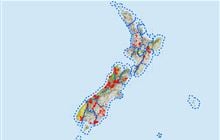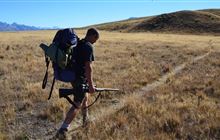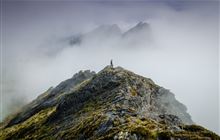Southern Kahurangi National Park hunting
Located in Nelson Lakes hunting in the Nelson/Tasman region
|
Introduction
Red deer, feral goats and pigs are distributed throughout the area. Chamois numbers are low and generally confined to the Mt Owen Massif area.Species
- Chamois
- Deer - Red
- Goats
- Pigs
Permit requirements
This hunting area is covered by an 'open area permit' – get it online or from a DOC office.
Dog access
About this hunting block
About the area
The Southern Kahurangi area includes the Hope Range, Matiri Valley, and Mt Owen including Sandstone, Fyfe and Owen river valleys.
Vegetation is mainly beech forest at low altitudes, with some areas of scrubland and old burns on the Hope Range and farm/park boundaries. The interior of Kahurangi National Park is steep and rugged in places, with large slips and areas of old earthquake damage particularly in the Matiri Valley.
Westerly driven weather systems arriving from the Tasman Sea are common and can cause the weather to change very quickly. Heavy rain will flood rivers that can become dangerous to the unwary, care needs to be taken at all times. Annual rainfall is around 3000 mm per year. Snow can fall above the bush line at any time of the year and visitors need to be well equipped.
Wasps in summer in beech forest can be a hazard and visitors need to be well prepared if allergic to stings.
Red deer are widely spread throughout the national park with the densest populations in the upper Matiri Valley.
The feral goat population throughout this area comes under sustained management by the Nelson Lakes Area Office goat control programme, with the aim of keeping their numbers down to a minimum. Assistance from hunters either destroying or reporting feral goats while hunting in the area would be appreciated by Area staff.
Feral pigs are distributed throughout, with heavier concentrations in the lighter cover and bush pasture margins. Chamois numbers are low and generally confined to the Mt Owen Massif area.
Access
State Highway 6 provides access along its length of the Hope Range, from Glenhope through to Owen Junction.
The Matiri Valley access is sign-posted from its junction with SH6 approximately 4 kms north of Murchison.
Mt Owen, and the Sandstone, Fyfe and Owen Rivers can be accessed by turning off SH6 onto the Owen River East Bank Road, just south of the Owen River Hotel.
Landholders
Mt Owen area: Ross Farrell, phone +64 3 523 9280
Any access over private land to the area requires landowner permission
Maps
NZTopo50 BR22, BR23, BR24
Dogs
Hunting dogs are allowed by permit only for day hunting (not overnight) within Kahurangi National Park, dog permits are available from the local DOC office.
Access in the Owen Valley is through private land, through which dogs are excluded without landowner permission.
Huts
The Matiri Valley system has four standard huts and one basic hut:
The Mt Owen Valley system has one Standard hut:
Additional information
Trout fishing in season is a very popular activity throughout the national park (Fish & Game licence required - see Fish & Game Council). The waters above Lake Matiri and the Fyfe river contain no trout.
Precautions to prevent the spread of didymo should be practiced at all times.
A blue duck/whio protection trap line runs in the Fyfe and Sandstone Rivers within the park. Any sightings of whio throughout the area would be appreciated by the local DOC office.
Contacts
| Whakatū / Nelson Visitor Centre | |
| Phone: | +64 3 546 9339 |
| Fax: | +64 4 471 1117 |
| Email: | nelsonvc@doc.govt.nz |
| Address: |
Millers Acre/Taha o te Awa 1/37 Halifax Street Nelson 7010 |
| Postal Address: |
Private Bag 5 Nelson 7042 |
| Full office details | |
| Rotoiti/Nelson Lakes Visitor Centre | |
|---|---|
| Phone | +64 3 521 1806 |
| nelsonlakesvc@doc.govt.nz | |
| Address | View Road St Arnaud 7072 |
| Hours | See visitor centre hours |



